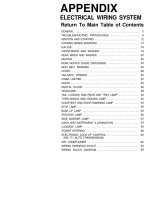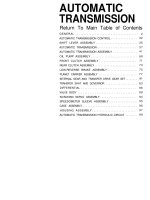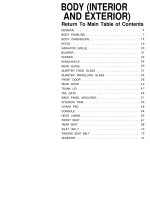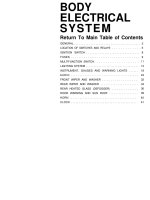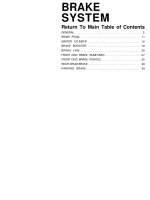Xe ô tô hyundai excel toàn tập hyundai excel - P15
Bạn đang xem bản rút gọn của tài liệu. Xem và tải ngay bản đầy đủ của tài liệu tại đây (1.62 MB, 72 trang )
FUEL
SYSTEM
Return To Main Table of Contents
GENERAL
........................................ 2
SERVICE ADJUSTMENT PROCEDURES
................ 29
FUEL TANK
.......................................
42
FUEL LINE
........................................... 45
FUEL PUMP
............................................ 47
CARBURETOR
......................................... 50
ENGINE CONTROL
. . . . . . . . . . . . . . . . . . . . . . . . . . . . . . . . . . . . .
70
GENERAL
GENERAL
SPECIFICATIONS
Fuel tank
Capacity [Original]
Capacity [Optional]
Fuel filter
Type [In-line filter]
Type [In-tank filter]
Fuel pump
Type
Driven by
Feed pressure
Carburetor
Type
Identification mark
For Federal - M/T
A/T
For California - M/T
A/T
Throttle bore
Primary
Secondary
Feedback solenoid valve (FBSV)
Type
Coil resistance
Slow cut solenoid valve (SCSV)
Type
Coil resistance
Throttle position sensor (TPS)
Type
Regulating voltage (When throttle
valve fully closed)
Coil resistance
Bow vent valve (BVV)
Type
Vacuum orifice
Mixture control valve (MCV)
Type
Air flowing quantity
Operating time
Dash pot
Type
Operating rpm (When SAS 2 touches
free lever)
Outer venturi dia.
Primary
Secondary
40 lit. (10.6 U.S. gal., 8.8 Imp.gal.)
50 lit. (13.2 U.S. gal., 11.0 Imp.gal)
Cartridge type
Open type
Mechanical diaphragm type
Camshaft
19-25 kPa (2.76-3.63 psi) at 2,500 rpm
Down-draft, 2-barrel, feed back type
410
411
412
413
30 mm (1.181 in.)
32 mm (1.260 in.)
Duty cycle solenoid
54-66 [At 20°C (68F)]
Duty cycle solenoid
48-60 [At 20°C (68°F)]
Variable resistor type (Rotary type)
0.25V
3.5 - 6.5
Vacuum type
0.3 mm (0.012 in.)
Vacuum type
5.1 ± 0.1 gr/sec.
0.8 ± 0.2 sec.
Conventional type
Approx. 1,800 rpm
20 mm (0.787 in.)
25 mm (0.984 in.)
31-2
GENERAL
Inner venturi dia.
Primary
Secondary
Main jet
Primary
Secondary
Main air jet
Primary - First
Second
Secondary
Pilot jet
Primary
Secondary
Pilot air jet
Primary - First
Second
Secondary
Main nozzle
Primary
Secondary
Throttle valve plate
Thickness
Primary
Secondary
Fuel closing angle
Primary
Secondary
Full opening angle
Enrichment jet
Slow air jet
Accelerating pump
Diaphragm dia.
Pump jet dia.
Choke
Type
Choke valve operating angle
Bimetal
Temperature constant
Spring constant
Choke breaker opening
First stage
Second stage
9-14 mm (0.354-0.551 in.)
9-12 mm (0.354-0.472 in.)
# 83.8
# 145
# 80
# 60
# 70
# 46.3
# 70
# 120
# 200
# 100
2.6 mm (0.102 in.)
2.8 mm (0.110 in.)
1.0 mm (0.040 in.)
1.5 mm (0.060 in.)
8°
15°
90°
# 50
# 110
24 mm (0.945 in.)
0.35 mm (0.014 in.)
Automatic (Electric type)
25° (When fully closed)
90° (When fully opened)
1.0 deg/°C
60 gr.mm/deg.
1.4-1.6 mm (0.056-0.064 in.)
2.9-3.1 mm (0.116-0.124 in.)
31-3
GENERAL
Electric control unit for FBC
Identification mark
For Federal - M/T
A/T
For California - M/T
A/T
Input sensor
Engine coolant temperature sensor
Type
Resistance
Oxygen sensor
Type
Vacuum switch
Type
Operating condition - ON
OFF
Vehicle speed sensor
Top gear sensing switch
Output actuator
Cold mixture heater
Type
Secondary air control solenoid valve
Type
Resistance
Advance control solenoid valve
Type
Resistance
Cold advance control solenoid valve
Type
Resistance
Throttle opener control solenoid valve
Type
Resistance
FOM 1
FOA 1
COM 1
COA 1
Thermistor type
2.5 [at 20°C (68°F)]
0.3 [at 80°C (176°F)]
Zirconia sensor
Contact type switch
More than 40 kPa (5.8 psi)
Less than 26 kPa (3.9 psi)
Reed switch type
Contact type switch
Positive Temperature Coefficient (PTC) heater
ON-OFF solenoid valve
38-44 [at 20°C (68°F)]
ON-OFF solenoid valve
38-44 [at 20°C (68°F)]
ON-OFF solenoid valve
38-44 [at 20°C (68°F)]
ON-OFF solenoid valve
38-44 [at 20°C (68°F)]
31-4
GENERAL
SERVICE STANDARD
Basic ignition timing
Curb idle speed
For the first 500 km (300 miles)
After 500 km (300 miles)
Throttle opener adjusting rpm for power steering and
electrical load
For the first 500 km (300 miles)
After 500 km (300 miles)
Throttle opener adjusting rpm for air conditioner load
BTDC 5° ± 2°
700
rpm
750 ± 100 rpm
800
rpm
850 ± 100 rpm
875 ± 25 rpm
TIGHTENING TORQUE
Nm
kg.cm Ib.ft
Accelerator arm bracket to body
7.8-12 80-120
5.8-8.7
Accelerator cable guide to body
2.9-4.9 30-50
2.2-3.6
Carburetor attaching bolt
15-20 150-200
11-14
Engine coolant temperature sensor
20-40 200-400
14-29
Oxygen sensor
39-49 400-500
29-36
Fuel tank drain plug
78-98 800-1,000
58-72
LUBRICANT
Grease for accelerator arm pin and return spring
Multipurpose grease SAE J310a, NLGI grade # 3
or equivalent
31-5
GENERAL
SPECIAL TOOLS
31-6
GENERAL
TROUBLESHOOTING
When checking and correcting engine troubles, it is important
to start with inspection of the basic systems. If you experience
one of the followings, (A) engine start failure, (B) unstable idling
or (C) poor acceleration, you should first check the following
basic systems.
1. Power supply
(a) Battery
(b) Fusible link
(c) Fuse
2. Body ground
3. Fuel supply
(a) Fuel line
(b) Fuel filter
(c) Fuel pump
4. Ignition system
(a) Spark plug
(b) High-tension cable
(c) Distributor
(d) Ignition coil
5. Emission control system
(a) PCV system
(b) EGR system
(c) Vacuum leak
6. Others
(a) Ignition timing
(b) Idle speed
Troubles with the FBC system are often caused by poor contact
of harness connector. It is, therefore, important to check har-
ness connector contact.
31-7
GENERAL
Fuel Tank and Fuel Line
Symptom
Engine malfunctions due to
insufficient fuel supply
Evaporative emission control
malfunctions (Pressure released
when fuel tank cap is removed)
Probable cause
Bent or kinked fuel pipe or hose
Clogged fuel pipe or hose
Clogged fuel filter or in-tank fuel filter
Water in fuel filter
Dirty or rusted fuel tank interior
Malfunctioning fuel pump (Clogged filter
in the pump)
Misrouted vapour lines
Disconnected vapor line piping joint
Folded, belt, cracked or clogged vapor line
Faulty fuel tank cap
Malfunctioning overfill limiter
(two-way valve)
Remedy
Repair or replace
Clean or replace
Replace
Replace the fuel filter or clean
the fuel tank and fuel line
Clean or replace
Replace
Correct
Correct
Replace
Replace
Replace
31-8
GENERAL
Carburetor and FBC System
Symptom
Engine will not start
or start to hard
Rough idle or engine
stalls
Carburetor
FBC system
Carburetor
FBC system
Probable cause
Choke valve remains open-cold engine
Improper choke breaker operation
Electric choke malfunction
Needle valve sticking or clogged
Engine coolant temperature sensor
malfunction
Vacuum hose disconnected or damaged
Slow-cut solenoid valve malfunction
Feedback solenoid valve malfunction
Vacuum switch malfunction-cold engine
Faulty ECU
Harness broken/short-circuited or
loose connection
Choke valve malfunction
Improper fast idle-cold engine
Improper idle adjustment
Electric choke malfunction
Primary pilot jet clogged
Dash pot malfunction
Slow-cut solenoid valve malfunction
Engine coolant temperature sensor
malfunction
Vacuum hose disconnected or damaged
Throttle position sensor malfunction
Engine speed sensor malfunction
Timing control system malfunction
Throttle opener control system
malfunction
Harness broken/short-circuited or
connector not connected securely
Remedy
Clean choke bore and linkage
Check and adjust choke breaker
Check electric choke body and
choke valve operation
Repair or replace
Check by using checker (Check
component and replace if faulty)
Repair or replace
Check component
Check component
Check component
Replace
Repair or replace
Clean choke bore and link
Adjust fast idle speed
Adjust idle speed
Check choke body and choke
valve operation
Clean up or replace
Adjust
Check drive signal by using
checker
Check component
Check by using checker (Check
component and replace if faulty)
Repair or replace
Check component and adjust
Check by using checker
Check harnesses for continuity
Check system. If faulty, check
components
Check system. If faulty, check
components
Repair or replace
31-9
GENERAL
Symptom
Engine hesitates or
poor acceleration
Engine dieseling
(runs after ignition
switch is turned off)
Poor fuel mileage
Carburetor
FBC system
Carburetor
FBC system
Carburetor
Probable cause
Acceleration pump malfunction
Choke valve remains open-cold engine
Choke valve remains closed-hot engine
Main jet clogged
Enrichment jet clogged
Secondary valve operation abnormal
Feedback solenoid valve malfunction
Vacuum switch malfunction
Timing control system malfunction
Timing control system malfunction
Engine coolant temperature sensor
malfunction
Throttle position sensor malfunction
Engine speed sensor malfunction
Cold mixture heater relay control system
malfunction-cold engine
Harness broken/short-circuited or
connector not connected properly
Air conditioner power relay control
system malfunction
Engine idle speed too high
Slow-cut solenoid valve malfunction
Choke valve operation abnormal
Engine idle speed too high
Electric choke malfunction
Enrichment valve kept open
Remedy
Clean pump discharge rate
Clean choke bore and link
Check choke valve operation
Clean choke bore and link
Check choke valve operation
Clean up
Clean up
Check valve operation
Check drive signal by using
checker
Check component
Check with checker (Replace
if faulty)
Check system. If faulty, check
components
Check system. If faulty, check
components
Check by using checker (Check
component and replace if faulty)
Check component and adjust
Check by using checker
Check harnesses for continuity
Check system. If faulty, check
components
Repair or replace
Check system
Adjust idle speed
Check component
Check valve operation
Adjust idle speed
Check choke body and valve
operation
Repair or replace
31-10
GENERAL
Symptom
Poor fuel mileage
FBC system
Probable cause
Engine coolant temperature sensor
malfunction
Oxygen sensor malfunction
Timing control system malfunction
Feedback solenoid valve malfunction
Slow-cut solenoid valve malfunction
Throttle position sensor malfunction
Engine speed sensor malfunction
Harness broken/short-circuited or
connector not connected securely
Remedy
Check by using checker
(Check component and replace
if faulty)
Check by using checker
(Check component and replace
if faulty)
Check system. If faulty, check
components
Check drive signal by using
checker
Check component
Check drive signal by using
checker
Check components
Check component and adjust
Check by using checker
Check harness for continuity
Repair or replace
31-11
GENERAL
GENERAL INFORMATION (FBC SYSTEM)
The Feedback Carburetor (FBC) system provides a positive air-
fuel ratio control for maximum reduction of emissions. The
Electric Control Unit (ECU) receives signals from various sen-
sors and then modulates two solenoid valves (FBSV, SCSV)
installed on the carburetor to control the air-fuel ratio.
The ECU also controls the ignition timing, electric choke, throt-
tle opener by switching on-off the solenoid valves.
FBSV : Feedback Solenoid Valve
SCSV : Slowcut Soldnoid Valve
ECU : Electric Control Unit
31-12
GENERAL
FBC System Diagram (For Federal Vehicles)
31-13
GENERAL
FBC System Diagram (For California Vehicles)
GENERAL
FBC System Circuit Diagram
GENERAL
FBC System Component
1. Electric Control Unit (ECU)
Based on the information from various sensors, the ECU deter-
mines (computes) ideal setting for varying operating conditions
and drives the output actuators to control the air-fuel ratio.
The ECU consists of an 8-bit microprocessor, random access
memory (RAM), read only memory (ROM) and input/output
(I/O) interface.
5. Cold spark advance control solenoid valve
6. Vacuum
7. –
8. Air conditioner cut relay
9. Secondary air control solenoid valve
10. Slow cut solenoid valve
11. Feedback solenoid valve
12. Idle up control solenoid valve
13. Distributor advance vacuum exchange solenoid valve
14. Electric choke relay
15. Ignition coil negative terminal
16. Ground
17. –
CONNECTOR B
1. Sensor power source (+)
2. Ground for sensor
3. Coolant temperature sensor (output)
4. –
5. Oxygen sensor (output)
6. –
7. Cold mixture heater relay (-)
8. –
9. Throttle position sensor (output)
CONNECTOR A
1. Battery back up
2. Power source
3. Power source
4. Ground
31-16
GENERAL
2. Engine Coolant Temperature Sensor
The engine coolant temperature sensor is installed in the
engine coolant passage of the intake manifold. This coolant
sensor is a thermistor. The ECU determines engine tempera-
ture by the sensor output voltage and utilize it to provide opti-
mum fuel enrichment when the engine is cold.
3. Throttle Pisition Sensor (TPS)
The TPS is a rotary type variable resistor that rotates together
with the carburetor throttle shaft to sense the throttle valve
angle. As the throttle shaft rotates, the TPS output voltage
changes and the ECU detects the throttle valve opening based
on the change of the voltage.
Using the TPS output signal, engine speed signal and other
signals, the ECU maintains the optimum air-fuel ratio.
4. Engine Speed Sensor
The ignition coil negative terminal voltage makes sudden
increase twice per crankshaft revolution synchronously with
ignition timing.
By sensing this ignition coil negative terminal voltage change
and measuring the time between peak voltages, the ECU com-
putes the engine speed, judges the engine operating mode and
controls the air-fuel ratio and ignition timing.
Low rpm
High rpm
GENERAL
5. Oxygen Sensor
(a) The oxygen sensor installed on the exhaust manifold makes
use of the principles of solid electrolyte oxygen concentra-
tion cell. The oxygen concentration cell is characterized by
sharp change of the output voltage in the vicinity of the
stoichiometric air-fuel ratio.
(b) Using such characteristics, the oxygen sensor senses the
oxygen concentration in the exhaust gas and feeds it to the
ECU. The ECU then judges if the air-fuel ratio is richer or
leaner as compared to the stoichiometric ratio and provides
feedback control to adjust the air-fuel ratio to the stoichio-
metric ratio where the emission purification rate of the
three way catalytic converter is the optimum.
6. Vacuum Switch
The vacuum switch is a contact type switch that is operated by
intake manifold vacuum. When the throttle valve closes, the
intake manifold vacuum acts on the vacuum switch to close its
contact.
By this action, the voltage on the ECU side is grounded and the
ECU senses that the throttle valve opening is near idle.
31-18
GENERAL
7. Feedback Solenoid Valve (FBSV)
The FBSV is installed in the carburetor float chamber cover.
The ECU controls the air-fuel ratio by controlling the duty cycle
of the FBSV.
The higher is the duty ratio, the leaner becomes the air-fuel
ratio.
NOTE
The duty cycle control means control of the solenoid valve
energization rate by changing the ON time ratio T2/T1 (called
duty ratio) of 10 Hz pulse.
8. Slow Cut Solenoid Valve (SCSV)
The SCSV is located in the carburetor float chamber cover. The
The ECU controls the carburetor slow system fuel flow by con-
trolling the duty cycle of the SCSV.
31-19
GENERAL
FBC System Operation
1. The air-fuel ratio control is maintained by the ECU in one of two
operating modes.
(a) Closed loop control (Feedback control)
After engine warm-up, the air-fuel ratio control is made by
the feedback control based on the oxygen sensor signal.
The oxygen sensor output voltage changes sharply at the
stoichiometric ratio. The control unit senses this oxygen
sensor signal and provides feedback control to the FBSV
maintaining the stoichiometric ratio that will give the best
purification rate of the 3-catalyst converter may be accu-
rately kept. In this state, the SCSV is kept wide open (100%
duty).
(b) Open loop control (No feedback control)
During engine start, warm-up operation, high load opera-
tion and deceleration, the air-fuel ratio is in open-loop. The
ECU controlled based on map values* established pre-
viously for engine speed, throttle valve opening angle and
engine coolant temperature, to improve startability and
driveability.
During deceleration, the SCSV limits fuel flow for better fuel
economy and for prevention of overheating of the catalysts.
*
Map value is a value previously established and stored in
ROM in ECU.
2. When the FBSV is energized, the main fuel jet is closed to
leaving the primary main jet passage as the only fuel passage.
This reduces the amount of fuel, resulting in leaner air-fuel
mixture.
3. When the FBSV is de-energized, the main fuel jet is opened to
provide two fuel passages including the primary main jet pas-
sage. Since this will increase the amount of fuel, richer air-fuel
mixture is obtained.
With the ON-OFF operation of SCSV, the slow fuel passage is
opened and closed.
The air-fuel ratio at deceleration is controlled in this manner.
31-20
GENERAL
Distributor Advance Control System (Ignition Timing
Control System)
The distributor vacuum advance is a dual diaphragm type hav-
ing main vacuum chamber and sub-vacuum chamber. To control
the ignition timing, the ECU energizes the solenoid valves in the
respective vacuum circuits of main vacuum chamber and sub-
vacuum chamber.
1. Main Vacuum Timing Control
(a) When the engine speed is near the idle speed (1,200 rpm or
less), the ECU energizes the distributor advance control
solenoid valve. By this action the carburetor D port vacuum
is introduced to the main vacuum chamber which resets the
ignition timing.
NOTE
The D port vacuum is zero when the throttle valve is at
idle position, and increases with the valve opening angle.
31-21
GENERAL
2.
Sub-vacuum Timing Control
(b) When the engine speed increases to 1,200 rpm the ECU
turns off the distributor advance control solenoid valve.
Intake manifold vacuum is routed to the main vacuum
chamber increasing ignition advance.
When the engine starts to warm up [engine coolant temper-
atures: below 80°C (176°F), the solenoids are energized,
allowing D port vacuum to reach main vacuum chamber.
o Control at low altitude [approx. 1,200 m (3,900 ft.) or lower]
(a) When the engine coolant temperature is low [50°C (122°F)
or lower], the ECU energizes the distributor cold advance
control solenoid valve. By this action, the intake manifold
vacuum no longer leaks from the High Altitude Compensa-
tor (HAC) to atmosphere and instead is introduced to the
sub-vacuum chamber. As a result, the timing advanced by
the main vacuum advance is additionally advanced by a
fixed angle (5°C in crank angle).
(b) During warm-up operation or when the engine coolant
temperature is high [over 50°C (122°F)], the ECU de-
energizes the distributor cold advance control solenoid
valve circuit. As a result, the intake manifold vacuum leaks
from the HAC to atmosphere, which prevents timing adv-
ance.
o Control at high altitude [approx, 1,200 m (3,900 ft.) or over)
At high altitude, the HAC is closed and hence the intake mani-
fold vacuum does not leak to atmosphere from the HAC. Inde-
pendently of the distributor cold advance control solenoid valve,
the intake manifold vacuum acts on the sub-vacuum chamber,
causing the timing to advance by a fixed angle (5° in crank
angle).
31-22
GENERAL
Throttle Opener System (For power steering and electrical
load)
If the power steering oil pressure switch is turned on by high
pump pressure the throttle opener control solenoid valve is
energized to introduce intake manifold vacuum to the throttle
opener. The throttle valve opens slightly, preventing engine
speed drop caused by power steering load.
When the engine speed drops below the set speed (1,200 rpm),
the ECU keeps the power transistor on. When the electrical load
switch is turned on for lighting etc., the throttle opener control
solenoid valve is energized, allowing intake manifold vacuum to
the throttle opener to open the throttle valve slightly, preventing
engine speed drop caused by electrical load.
31-23
GENERAL
Throttle Opener System (For A/C)
When the engine speed is below the set speed (1,200 rpm), the
ECU keeps the power transistor on. When the air conditioner
relay is turned on the throttle opener control solenoid valve is
energized to introduce intake manifold vacuum to the throttle
opener. The throttle valve opens slightly preventing engine,
speed drop caused by air conditioner load.
Air Conditioner Power Relay Control System (For A/T)
When the throttle valve opening increases (over 74°) during
acceleration etc., the ECU turns off the air conditioning power
relay for about 5 seconds. As a result, even if the air conditioner
switch it is, the air compressor is not driven and hence the
engine load is reduced, improving acceleration performance.
31-24
GENERAL
Cold Mixture Heater (CMH) Relay Control System
The cold mixture heater is a Positive Temperature Coefficient
(PTC) heater installed between the carburetor and intake
manifold.
When the engine coolant temperature is below 60°C (140°F),
the ECU energizes the cold mixture heater relay. The closed
relay supplies voltage to the cold mixture heater. The cool air-’
fuel mixture is heated and atomized by the heater before it
reaches the combustion chamber for improved combustion.
31-25




